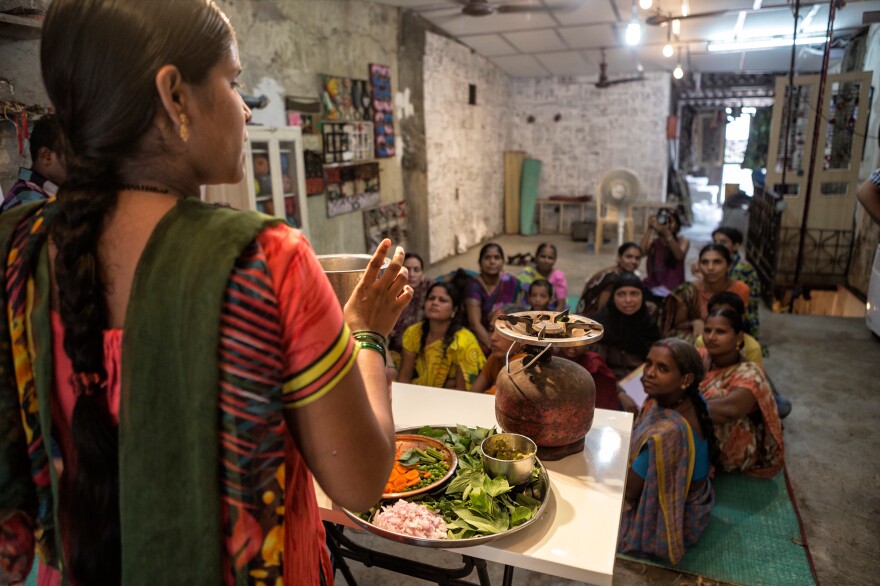Once Mumbai's largest slum, Dharavi — made famous by the 2008 movie Slumdog Millionaire — is a teeming multi-ethnic and multicultural settlement claiming almost a million migrants from across India.
Dharavi houses hundreds of cottage and small-scale industries, run mostly by men, who make products like bags and belts, zari embroidery and pottery. It's also known for its huge recycling industry. Together, these enterprises generate more than $650 million a year, according to some reports.
In Dharavi, lower and lower-middle income residents pack their large families, sometimes 15 or 16 people, into small houses, where women manage all household work and have little opportunity for social interaction.
So when some of Dharavi's women joined a workshop expecting demonstrations on contemporary cuisine from art historian Prajna Desai, they were surprised to learn it was their recipes she was after.
"Most women who attended my workshop shared that they don't often leave home unless it is to run a specific errand or to take kids to school," Desai says. "At first, they were confused why anyone would even care to know what they were cooking every day."
Desai held 13 workshops between June and September 2014 — and eight of the women were able to attend every meeting, a commitment required to be part of the book she planned to publish. Desai's new cookbook, The Indecisive Chicken: Stories And Recipes From Eight Dharavi Cooks, draws attention to what India's working class cooks — and eats — every day.
The book evolved from Dharavi Biennale 2015 — a two-year joint initiative between the Mumbai charity SNEHA, which works to improve women's health, and Wellcome Trust, a U.K.-based philanthropic group dedicated to improving global health — that culminated in an exhibition in Dharavi. The goal was to both discuss health issues with the residents of the slum — and to acknowledge their somewhat underestimated contribution to the city's economic and cultural life.

Desai's workshop included discussions on nutrition, self-worth, food aesthetics, women's labor and more. Mumbai-born, Desai is an art historian and curator of contemporary art with a doctorate in pre-Columbian art and architecture from Yale University. She splits her time between Mumbai and Tokyo.
The Indecisive Chicken combines the recipes and life stories of the eight women from Dharavi. The recipes are traditional, ones they cook at home regularly and consider unique to their community or region of origin. Some are unique to their families. These dishes are delectable, yet missing from the menus of restaurants that serve Indian food.
The book showcases cuisine from women of India's working class. A monograph on each contributor transports the reader into her world and gives a peek into the contemporary history of Dharavi, which is really a microcosm of India.
The Indecisive Chicken gets its name from a story told by one of the Dharavi women, who said she didn't cook chicken because her husband thinks it's a "silly bird" — and then reflected that he didn't really like chicken, anyway.
Desai's book isn't about "curries," as Indian food is largely interpreted in the West. With an assortment of 35 recipes originating from communities all around India, it offers an eye-opening look at the sheer diversity of Indian cooking.
Kavita Kawalkar, who has roots in the South Indian state Andhra Pradesh, provides a recipe for ambadi pulao, a main rice dish packed with carrots and moringa — a tropical plant, known in India as "drumstick tree," whose nutritious leaves and pods are a staple. She uses ambadi, the sour leaves of Hibiscus cannabinus, to make this light, flaky pilaf.

"This dish is completely unheard of in restaurants," says Desai, as are most of the other recipes covered in the 196-page bilingual English-Hindi book. Kawalkar's technique of roasting base ingredients, such as onions and dry coconut, on fire creates a silkier feel and mellower tone in her preparations.
Meanwhile, another contributor, Sarita Rai, offers a recipe for pharas, "semi-circular pockets of rice dough" with a filling of split Bengal gram (or chickpea flour) and split black gram, served steamed or deep-fried. Rai is a shy mother of three who migrated to Dharavi eight years ago from a village in the North Indian state of Uttar Pradesh. Desai calls Rai a "silent philosopher" who prefers to observe quietly, but comes alive when conversations about cooking begin to flow. With pharas and another recipe, for alu puri — deep-fried Indian bread with potato stuffing — Rai brings the North Indian tradition of frying to the table.
Though many women in Dharavi stay home, a few hold jobs in addition to being responsible for the household. Rajani Borse, who contributes recipes from Maharashtra, a Western Indian state, is an Anganwadi worker: Her job, for the government, is to combat hunger and malnutrition among children from low-income groups. Borse spends a lot of her time after work caring for her parents who live with her.
Despite hailing from diverse regions of India, speaking different languages and honoring varying traditions, the women featured in the book have some common perceptions toward cooking and self-worth.
"They were surprised at being appreciated, as producers, thinkers and teachers even, of an everyday process [cooking] that the workshops revealed as something akin to art," Desai says.
Desai's book, she writes, is a window into Dharavi's diverse food culture. "Fine dining, one learns, does not reside only in restaurants. It brims up from homes, returns into it, and resurges through the heroism of such cooks."
Priti Salian is a Bangalore-based journalist who covers culture, travel and human-interest stories for The Guardian, CNN, The Christian Science Monitor, GOOD, Al Jazeera and many other publications.
Copyright 2023 NPR. To see more, visit https://www.npr.org.



